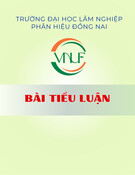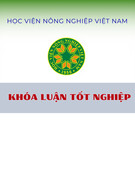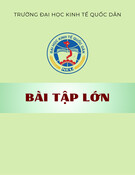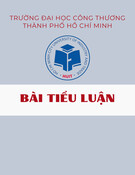
B. Hannrup et al.Genetic parameters for spiral grain
Original article
Genetic parameters for spiral-grain angle in two 19-year-old clonal
Norway spruce trials
Björn Hannrupa*, Michael Grabnerb, Bo Karlssonc, Ulrich Müllerd, Sabine Rosnerb,
Lars Wilhelmssonaand Rupert Wimmerb
aSkogForsk, Science Park, 751 83 Uppsala, Sweden
bInstitute of Botany, Universität für Bodenkultur Wien, Gregor Mendelstrasse 33, 1180 Vienna, Austria
cSkogForsk, Ekebo, 268 90 Svalöv, Sweden
dInstitute of Wood Science and Technology, Universität für Bodenkultur Wien, Gregor Mendelstrasse 33, 1180 Vienna, Austria
(Received 16 August 2001; accepted 17 June 2002)
Abstract – Spiral grain was measured for all annual rings on wood discs taken at a single sampling height from two 19-year-old (field age) Nor-
way spruce (Picea abies (L.) Karst.) clonal trials. In both trials, the mean grain angle reached a maximum inclination to the left at ring number 4,
followed by a monotonic decrease towards a right-handed inclination. Clonal means of mean grain angle of rings 3 to 15 ranged from 0.5 to
4.7 degrees and from –0.2 to 5.3 degrees in the two trials, respectively. The broad-sense heritability of mean grain angle was 0.42 in both trials
and the slope of the radial grain-angle development showed heritabilities varying between 0.26 and 0.40. Estimates of genotypic correlations in-
dicated that clones with a high grain angle in the inner rings tended to have a more rapid development towards a straight angle in the following
rings. Selection based on any of the rings in the interval from ring numbers 5 to 10 was most efficient in decreasing the average grain spirality at
the sampling level considered.
spiral grain / heritability / genotypic correlation / correlated response
Résumé – Paramètres génétiques de l’angle du fil du bois dans 2 tests clonaux d’Épicéa commun âgés de 19 ans. L’angle du fil du bois a été
mesuré pour tous les cernes à partir de disques prélevés à la même hauteur dans 2 tests clonaux d’Épicéa commun (Picea abies (L.) Karst.) âgés
de 19 ans. Dans les 2 dispositifs, l’angle moyen atteint une inclinaison maximale à gauche au cerne 4. Elle est suivie d’une diminution monoto-
nique de l’angle vers une inclinaison à droite. Les moyennes clonales de l’angle moyen des cernes 3 à 15 s’étalent de 0,5 à 4,7 degrés et de –0,2 à
5,3 degrés respectivement dans les deux tests. L’héritabilité au sens large de l’angle du fil est de 0,42 dans les 2 essais et la pente de la régression
de l’angle sur les cernes annuels présente une héritabilité variant entre 0,26 et 0,40. Les corrélations génotypiques montrent que les clones avec
un angle élevé dans les cernes proches de la moëlle ont tendance à présenter une évolution plus rapide de l’angle vers un angle droit dans les cer-
nes suivants. Une sélection basée sur un des cernes compris entre le 5eet le 10eest apparue plus efficace pour diminuer l’angle moyen du fil au ni-
veau de l’échantillon considéré.
angle du fil / héritabilité / corrélation génotypique / gain génétique
1. INTRODUCTION
The term spiral grain is applied to the helical orientation of
the tracheids in a tree stem, which gives a twisted appearance
to the trunk after the bark has been removed [24]. The
spirality may be either right- or left-handed, the slope may be
constant in a given tree or may change with age. Spiral grain
is a topic of considerable importance to end-users, as grain
deviation from the vertical axis may cause technological dif-
ficulties such as warping [28] and, when severe, also reduced
strength properties [20]. Recent studies of end-user expecta-
tions on structural lumber have stressed particularly the
Ann. For. Sci. 59 (2002) 551–556 551
© INRA, EDP Sciences, 2002
DOI: 10.1051/forest:2002040
* Correspondence and reprints
Tel.: +46 18 18 85 00; fax: +46 18 18 86 00; e-mail: bjorn.hannrup@skogforsk.se

importance of shape stability [18, 27]. Among the different
types of distortions, twist was shown to be the most severe
type in coniferous species causing downgrading or rejection
of a significant proportion of the lumber [15, 33]. Spiral grain
is strongly associated with twist [5, 7] and the degree of twist
may be predicted from the ratio of grain angle to the distance
from the pith [1] indicating that, for a given grain angle, wood
formed closer to the pith will twist more compared to wood
formed far from the pith. Furthermore, in plantation-grown
conifers, high grain angles are most commonly found in the
juvenile wood. For instance, in Norway spruce, a left-handed
spirality tend to increase from the pith outwards until a maxi-
mum has been reached at about ring number 4, followed by a
steady decrease to zero inclination or right-handed spirality
[6, 25]. Thus, decreasing grain angle is a major goal to reduce
twist, especially in fast growing species with high propor-
tions of juvenile wood.
In Norway spruce, little information is available on the ge-
netics of spiral grain. The only published study in this species
showed narrow-sense heritabilities in the range of 0.29 to
0.47, for grain angle measured in ring numbers 11 or 12 from
the pith in four trials [3]. This study also reported a low geno-
type by environment interaction for spiral grain and a moder-
ate positive correlation between grain angle and stem
diameter [3]. However, most published genetic parameters of
grain angle in the juvenile wood are from radiata pine and
Sitka spruce. For the former species, Sorensson et al. [30]
concluded that the grain angle of the juvenile wood had a
moderate to high heritability and a large phenotypic varia-
tion. For Sitka spruce, the narrow-sense heritability of grain
angle in three trials ranged from 0.36 to 0.78 [10, 12],
whereas broad-sense heritability in four trials ranged from
0.36 to 0.54 [11]. The additive genetic standard deviation was
in the range between 1.3 and 1.7 degrees [10, 12]. In Sitka
spruce (ring number 10) [12] and Norway spruce (ring num-
bers 11 or 12) [4], selection against spirality led to predicted
reductions of grain angle varying between 0.5° and 1.0o.
To develop an efficient sampling strategy for grain angles
in Sitka spruce, Hansen & Roulund [13] studied the relation-
ship between grain angle of annual rings at 1.3 m above
ground and whole tree grain angle values and obtained corre-
lation coefficients ranging from 0.83 to 0.98, between clonal
means of two rings at 1.3 m and whole tree clonal means
(mean values of all rings at 5 height levels) indicating that it is
sufficient to sample ramets at one height level to obtain an ac-
curate whole-tree value per clone. For radiata pine,
Sorensson et al. [30] reached a similar conclusion and found
grain angles measured in ring number 6 to 8 at 1.4 m above
ground to be most efficient.
The aim of the present study was to estimate genetic pa-
rameters of grain angle characters in two Norway spruce
clonal trials. The genetic parameters were used to calculate
the expected correlated response of mean grain angle to se-
lection for reduced grain inclination of individual rings. This
provided an indication of the most efficient age to select for
decreasing the average grain spirality of the juvenile wood.
2. MATERIALS AND METHODS
2.1. Plant material
Two 19-year-old (field age) clonal field trials grown at
Hermanstorp (56° 45’, 15° 02’; 180 m elevation) and Knutstorp
(55° 58’, 13° 18’; 75 m elevation) in southern Sweden were utilized
in the study. Two-seasons old rooted cuttings were randomly
planted as 2 ×2 m spaced single-tree plots in five blocks with one
cutting per clone and block. At Hermanstorp and Knutstorp there
were 60 and 67 clones, respectively. The clones were originally se-
lected for their superior nursery height growth in commercial seed-
ling stocks of six Slovakian provenances. Nursery selection effects
were assumed insignificant for the purpose of this study [17]. The
provenances originated from a narrow geographical range, lat.
48° 46’–49° 27’, long. 19° 15’–20° 15’ and altitude 650–880 m.
Both trials are located on high-productive sites, formerly used as ag-
ricultural land.
Wood samples were collected from a subset of clones. All the
20 clones common to both sites were used and, in addition, a random
sample was taken from clones with at least four surviving ramets per
site. At Hermanstorp 182 ramets from 43 clones were used and
125 ramets from 30 clones were used at Knutstorp. Ten cm thick
stem discs were taken from all trees at the first internode above
80 cm.
2.2. Measurement of spiral grain
The first question to be considered when measuring spiral grain
is the axis of reference. It is generally agreed that the grain angle re-
fers to the angle between the longitudinal wood elements and the
axis of the stem [13]. In this work the pith was used as a reference
[22] and the inclination of the longitudinally wood elements against
the pith can be measured with high accuracy. Also, the objectives of
our study suggested to use the pith as a reference rather than the log
axis [2], the latter being of more practical significance for spiral
grain studies in timber [13]. The sampled disks were split using a
wedge-sharped blade and a mallet to expose the pith and the grain
angle on the split surface. The pith was then fixed to pins of a mov-
able bar, which was part of a precicely manufactured protractor de-
vice (figure 1). Visibility of the grain orientation was improved by
scratching the tangential surfaces along the fibres and marking these
scratches with a pencil [32]. Angles were recorded with the build-in
protractor and positive angles were defined as a left-handed spirality
and negative one as a right-handed spirality. Sinuous stem growth
[31] and other pith irregularities were not observed in the investi-
gated trees.
2.3. Statistical analysis
The following measured and derived characters were included in
the statistical analyses: (GA_), grain angle of individual rings in the
interval of annual ring numbers 3 to 15; (GA3_15), arithmetic mean
of the grain angle of the annual rings 3 to 15; (b_GA4_15), slope of
the linear regression of grain angle on ring number from the pith for
ring numbers 4 to 15. Data from annual rings 1 to 3 were not in-
cluded in the regression as these rings showed a different trend. A
regression model with the logarithm of the grain angle data were
552 B. Hannrup et al.

tested but rejected, as it did not provide a better fit than the model
with untransformed values.
The statistical analysis was made in two steps: (i) univariate
analysis, where variance components for each character within each
trial were estimated; (ii) multivariate analysis, where variances and
covariances between pairs of characters within trials were esti-
mated. The following mixed linear model was used in the univariate
analyses:
y1=X1b1+Z1c1+e1(1)
The following two-character model, which is an extension of [1],
was used in the multivariate analyses:
y
y
X0
0X
b
b
Z0
0Z
c
c
1
2
1
2
1
2
1
2
1
2
=
+
+
e
e
1
2(2)
where y1and y2are observation vectors for the traits, X1and X2are
design matrices for fixed block effects, b1and b2are vectors of fixed
block effects, Z1and Z2are design matrices for random clone ef-
fects, c1and c2are vectors of random clone effects, e1and e2are vec-
tors of random residuals.
The models did originally include the fixed effect of provenance
but this effect was subsequently removed, as it turned out to be
non-significant for all the grain-angle characters studied.
The random factors are assumed to be normally distributed with
expectation of zero, leading to
Ey
y
Xb
Xb
1
2
11
22
=
and with the variance-covariance matrix assumed to be
Var c
e
GI0
0R I
=⊗
⊗
where Gis the matrix with the clonal variances and covariances, R
is the matrix with the residual variances and covariances and Iis an
identity matrix. Finally, ⊗symbolises the direct product.
The genotypic($)σG
2, environmental($)σE
2and phenotypic($)σP
2
variance components were estimated as:
($)(
$)σσ
Gc
22
=
($)(
$)σσ
Ee
22
=
($)(
$)(
$)σσσ
PGE
222
=+
where $
σc
2and $
σe
2are the estimated clonal and residual variances, re-
spectively.
The estimates of broad-sense heritability($)H2and genotypic cor-
relation ($)rgbetween characters within sites were obtained by
$
$
$
H22
2
=σ
σ
G
P
and
$
$
$$
rg
GG
GG
1
12
=σ
σσ
2where $
σGG
12
is the estimated genotypic covariance be-
tween characters.
The statistical analysis was based on Henderson’s [16] mixed
model equations (MME) and variances and covariances were esti-
mated with the Average Information algorithm [9] for restricted
maximum likelihood (REML) [26, 29] estimates, as implemented in
the ASReml software [8]. Estimates of the standard errors of the ge-
netic parameters were calculated from a Taylor series approxima-
tion as performed in the ASReml software [8].
The expected correlated response (RSE) of mean grain angle in
the juvenile wood to selection for grain angle of individual rings was
calculated as:
RSE xxygP
y
y
=iHHr
X
$$
$$
σ
where iis the selection intensity, $
His the square root of the
broad-sense heritability, $
rgis the genotypic correlation, $
σPis the
phenotypic standard deviation, Xis the phenotypic mean and x and y
are the indices for grain angle of individual rings and mean grain an-
gle of ring 3 to 15, respectively. A selection intensity of 1.0 was
used.
3. RESULTS
Starting from the pith, the mean spiral grain reached a
maximum value in ring number four followed by a
monotonic decrease (table I). This trend was common to both
trials, with Knutstorp having higher angles in the rings clos-
est to the pith. For the mean grain angle of rings 3 to 15 the
clonal mean values ranged from 0.5 to 4.7 degrees at
Hermanstorp and from –0.2 to 5.3 degrees at Knutstorp (data
not shown).
The broad-sense heritability of grain angle of individual
rings were moderate to high and no clear age trend was ob-
served (table I). The trials showed identical heritability
values for the mean grain angle of rings 3 to 15 (H2= 0.42).
The average genotypic standard deviation for grain angle of
individual rings were 1.0 and 1.1 degrees at Hermanstorp and
Knutstorp, respectively. The slope of the regression of grain
angle on ring number from the pith was heritable, with H2
Genetic parameters for spiral grain 553
Figure 1. Apparatus to measure grain angle relative to the pith. The
wooden frame has a built-in sliding bar, to which the sample is at-
tached and aligned with the pith. Grain direction is marked on the sur-
face and the angle is measured with the calibrated inclinometer. Grain
angles were re-measured as the ring layers are sequentially removed
with a chisel.

ranging from 0.26 at Knutstorp to 0.40 at Hermanstorp
(table I).
The genotypic correlations between the grain angle of in-
dividual rings and the mean grain angle of rings 3 to 15 were
high and, with exception of the two innermost rings, above
0.8 (table II). The expected correlated response in mean grain
angle of rings 3 to 15 following indirect selection for grain
angle of the individual rings is shown in table III. Con-
sidering both trials, the strongest correlated responses were
achieved when selection was based on any of the tree rings
between the 5th and the 10th ring.
The genotypic correlations between the slope of the re-
gression of grain angle on ring number from pith and grain
angle of the individual rings were highly negative in the rings
closest to the pith (figure 2). This indicates that clones with
high grain angle in the rings closest to the pith tended to have
a more rapid development towards a straight angle in the fol-
lowing rings.
554 B. Hannrup et al.
Table I. Number of observations, arithmetic mean values with standard deviations in parentheses and broad-sense heritabilities with standard er-
rors in parentheses for spiral-grain angle characters. See the Materials and Methods section for an explanation of the characters.
N Mean (S.D.) H2(S.E.)
Trait Ring no. Hermanstorp Knutstorp Hermanstorp Knutstorp Hermanstorp Knutstorp
GA_2 2 44 19 1.7 (1.4) 3.6 (1.4) * *
GA_3 3 138 77 3.3 (1.3) 4.1 (1.7) 0.26 (0.10) 0.32 (0.13)
GA_4 4 162 103 3.8 (1.3) 4.1 (1.7) 0.30 (0.09) 0.44 (0.11)
GA_5 5 164 115 3.6 (1.6) 3.9 (2.2) 0.42 (0.09) 0.42 (0.10)
GA_6 6 167 115 3.3 (1.6) 3.3 (2.1) 0.47 (0.08) 0.34 (0.10)
GA_7 7 167 115 3.0 (1.5) 2.8 (1.9) 0.47 (0.08) 0.42 (0.10)
GA_8 8 168 115 2.8 (1.5) 2.7 (2.0) 0.41 (0.09) 0.35 (0.10)
GA_9 9 168 115 2.4 (1.6) 2.4 (2.0) 0.42 (0.09) 0.37 (0.10)
GA_10 10 167 115 2.1 (1.6) 2.1 (2.0) 0.41 (0.08) 0.40 (0.10)
GA_11 11 165 115 1.8 (1.5) 1.9 (1.9) 0.42 (0.09) 0.30 (0.10)
GA_12 12 166 114 1.6 (1.6) 1.9 (2.0) 0.35 (0.09) 0.27 (0.10)
GA_13 13 163 112 1.3 (1.6) 1.7 (2.0) 0.34 (0.09) 0.23 (0.10)
GA_14 14 154 102 1.2 (1.6) 1.5 (2.0) 0.38 (0.09) 0.28 (0.10)
GA_15 15 143 80 1.1 (1.6) 1.6 (1. 8) 0.31 (0.09) 0.30 (0.12)
GA_16 16 65 36 1.2 (1.9) 1.3 (2.2) * *
GA3_15 3–15 168 115 2.4 (1.4) 2.6 (1.6) 0.42 (0.08) 0.42 (0.10)
b_GA4_15 4–15 168 115 –0.27 (0.15) –0.25 (0.22) 0.40 (0.08) 0.26 (0.10)
* Not estimated due to the low number of observations.
Figure 2. Genotypic correlations between the slope of the regression
of grain angle on ring number from the pith and the grain angle of in-
dividual rings.
Table II. Genotypic correlation (rG) with standard error in parenthe-
ses between spiral-grain angle of individual year rings and mean spi-
ral-grain angle of year ring 3 to 15.
rG(S.E.)
Trait 1 Trait 2 Hermanstorp Knutstorp
GA3 GA3_15 0.50 (0.20) 0.52 (0.23)
GA4 GA3_15 0.76 (0.11) 0.66 (0.15)
GA5 GA3_15 0.85 (0.06) 0.90 (0.07)
GA6 GA3_15 0.93 (0.04) 1.00 (0.04)
GA7 GA3_15 0.95 (0.03) 0.92 (0.05)
GA8 GA3_15 0.96 (0.03) 0.96 (0.03)
GA9 GA3_15 0.97 (0.02) 0.98 (0.03)
GA10 GA3_15 0.96 (0.02) 0.98 (0.03)
GA11 GA3_15 0.99 (0.01) 0.88 (0.07)
GA12 GA3_15 0.94 (0.03) 0.90 (0.07)
GA13 GA3_15 0.93 (0.03) 0.89 (0.09)
GA14 GA3_15 0.94 (0.03) 0.87 (0.09)
GA15 GA3_15 0.89 (0.05) 0.86 (0.10)

4. DISCUSSION
The tendency of spiral grain to increase outwards from the
pith until a maximum after a few rings, and then followed by
a gradual decrease, has been observed in spruce trees (in
Sitka spruce: [13]; in Norway spruce: [6, 25]). The measured
angles and peak position also agree with Danborg’s study [6]
in Norway spruce. In our study, the radial trends for grain an-
gle at the two trials were similar. This may indicate similarity
of the environmental conditions at the two sites, as well as the
fact that several of the tested clones were common to both
sites.
As clones were used, it was not possible to split the
genotypic variance into additive and dominance variance.
However, in the only published study reporting genetic pa-
rameters for spiral grain in Norway spruce, the results indi-
cated that the dominating part of the genotypic variance is
additive [3]. Furthermore, in the same study, the additive ge-
netic variance for grain angle of the annual rings 11–12
ranged from 0.99 to 1.21 in three trials, and was 0.38 in a
fourth trial. Under the assumption that most of the genotypic
variance is additive, these results agree with the present
study, where the genotypic variance for grain angle in the
corresponding annual rings ranged from 0.9 to 1.1 degrees
across the two trials.
The genotypic correlations between the grain angle of in-
dividual rings and the mean grain angle of rings 3–15 were
generally highly positive (table II). For the sampling level
considered, this indicates that an efficient selection for re-
duced grain angle in the juvenile wood may be accomplished
by using grain angle data of individual rings. This is encour-
aging since there is currently no easy and non-destructive
method to measure grain angle of all year rings. Noskowiak
[23] was able to measure spiral angle on increment cores,
which is still a semi-destructive method for young trees. The
present work indicated that the strongest reduction of juve-
nile wood grain angles was achieved for selection based on
one of the annual rings among the numbers 5 to 10 (table III).
Ring numbers 5 to 10 correspond to a field age of 8 to
13 years, as it took on average 3 years for the cuttings to reach
the sampling height considered. In the Swedish Norway
spruce breeding program, final measurement of growth char-
acteristics are usually carried out at a field age of 10 to
15 years. Thus, the results obtained indicate that it will be ef-
ficient to measure grain angle at the time when the growth
characteristics are evaluated.
The grain angle of the outermost annual ring may be mea-
sured between two selected branch whorls or at a given
height. The first type allows the generation of grain angle
data with respect to cambial age and the second method with
respect to the year of formation. In the present study, it was
possible to analyse grain angle with respect to both cambial
age and chronological year. The heritabilities for grain angle
of individual rings were similar in both cases (data not
shown). This indicates that, for selection purposes, it is
equally efficient to base grain angle measurements either on
cambial age or on the chronological year of ring formation.
The medium to high broad-sense heritabilities for grain
angle in individual rings agreed with estimates obtained for
Sitka spruce [11] and other conifers (for review, see [14]).
Clonal differences were found in the radial pattern of grain
spirality as shown by the medium to high broad-sense
heritabilities for the slope of the regression of grain angle on
ring number from the pith (table I). Depending on the age of
selection the effect on the radial pattern will vary. The
genotypic correlation between the slope of the regression of
grain angle on ring number from pith and the grain angle of
Genetic parameters for spiral grain 555
Figure 3. Mean grain angle per annual ring across trials and clonal
means per ring for three clones with a tendency to retain the
left-handed spirality.
Table III. Expected correlated response in mean spiral-grain angle of
ring number 3 to 15 following an indirect selection based on spi-
ral-grain angle in individual rings.
Selection
trait
Response
trait
Correlated response (%)
Hermanstorp Knutstorp
GA3 GA3_15 –9.2 –11.4
GA4 GA3_15 –15.1 –16.9
GA5 GA3_15 –20.0 –22.5
GA6 GA3_15 –23.1 –22.5
GA7 GA3_15 –23.6 –23.0
GA8 GA3_15 –22.3 –21.9
GA9 GA3_15 –22.8 –23.0
GA10 GA3_15 –22.3 –23.9
GA11 GA3_15 –23.2 –18.6
GA12 GA3_15 –20.1 –18.1
GA13 GA3_15 –19.6 –16.5
GA14 GA3_15 –21.0 –17.8
GA15 GA3_15 –18.0 –18.2


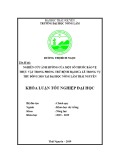
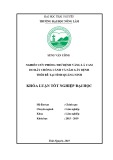
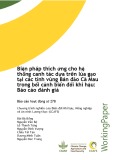

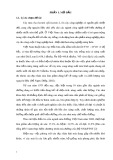
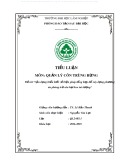
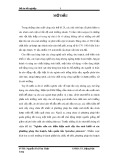

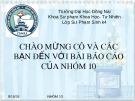

![Bệnh Leptospirosis: Khóa luận tốt nghiệp [Nghiên cứu mới nhất]](https://cdn.tailieu.vn/images/document/thumbnail/2025/20250827/fansubet/135x160/63991756280412.jpg)
